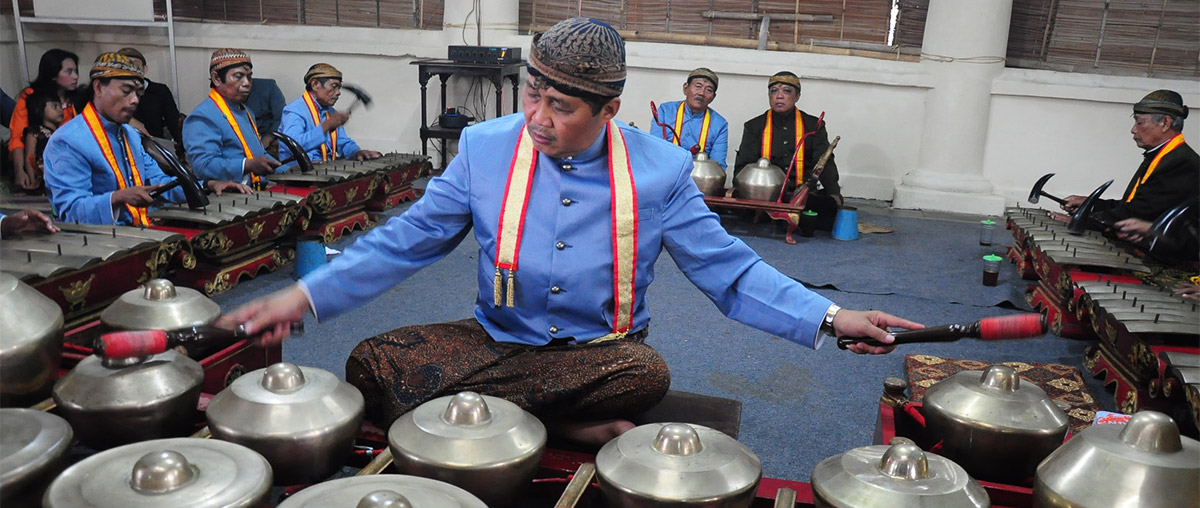Cornell University Library Digital Collections
Indonesian Music Archive
The Indonesian Music Archive consists of approximately 193 hours of audio recordings made in Indonesia between 1952 and 1977. The great majority are of Central Javanese gamelan, but there are also significant recordings of traditional music, ritual, and story telling from other locations in Java, Lombok, and Aceh.
The collection began its life as the “Archive of Field Recordings,” a project initiated by then-graduate student John Pemberton (PhD 1989, now in the anthropology department at Columbia University) that brought together and documented reel-to-reel recordings, most of them made in the 1970s in the court cities of Surakarta and Yogyakarta. Many of these recordings were made by Pemberton himself. Others were made by fellow Cornellians Nancy Florida (PhD 1990), Jennifer Lindsay (MA 1980), and Emeritus Professor Martin Hatch, while still others were contributed by fellow researchers and enthusiasts of Javanese gamelan, including Alan Feinstein, Alex Dea, and Laurie Kottmeyer. There are also some older recordings from Java, including those contributed by Konservatori Karawitan Surakarta from 1952, just two years after its founding. There are also recordings from the Kraton Surakarta from 1965 contributed by Nusyirwan Tirtaamijaya and the late Emeritus Professor Benedict Anderson, and a recording of dance repertoire recorded by Benedictus Soeharto in Yogyakarta in 1967.
Of the recordings of Central Javanese gamelan, the principal focus is the core repertoire of Surakarta-style gendhing, though there is also a recording of Yogyakarta-style gendhing from 1975. There are recordings of specially arranged sessions, for the purpose of individual study and to document outstanding musicians, from lesson recordings (of R.L. Martopangrawit playing gendèr, Soekanto Sastrodarsono playing kendhang, and of the pesindhèn Tugini); through recordings featuring two or three musicians (such as the female gendèr player Gandasuraya, R.Ng. Gunopangrawit playing rebab, and the pesindhèn Nyai Bei Mardusari); to full ensembles, including sessions recorded from multiple perspectives (from January 1971, March of 1976, as well as a recording of gendhing Onang-Onang featuring R.L. Mloyowidodo playing bonang). Other recordings capture this repertoire played in particular settings for particular occasions, including live broadcasts marking the wiyosan (35-day birthday) of the monarchs from different palaces (Kraton Surakarta, Istana Mangkunegaran, Pura Paku Alaman); recordings for broadcast from the Surakarta studios of Radio Republik Indonesia; and klenéngan (musical gatherings) at private residences.
Other recordings capture other facets of Javanese music and sound: wayang purwa, the most common form of puppet theater in Java, performed by Ki R. Sutrisno, Ki Suratno Gunowiharjo, and Ki Anom Soeroto; a performance of the less common wayang klitik by an unidentified performer in 1969; the ceremonial gamelan sekaten from Yogyakarta and Surakarta, as well as the soundscape of the surrounding festival, and the performance of gamelan kodhok ngorek to signal the end of the festivities; a practice of other archaic gamelan at the Istana Mangkunegaran; a broadcast of the Islamic vocal genre larasmadya; the poetic form macapat sung by R.L. Kridhaswara, Widarsih, and Suwarto; and siteran (street music by singers accompanied by zithers) from the Pasar Kembang in Yogyakarta.
From beyond Java there are two significant contributions. There are recordings of sung verse made by Emeritus Professor James Siegel in Aceh in 1968, including a complete performance of Hikayat Malam Diwa. There are also recordings of music and ritual from Lombok, made by Judith Ecklund (PhD 1977). A good number are of these are of bronze gamelan, including gamelan gong Sasak and the processional gamelan tawaq-tawaq, but there are also recordings of gamelan klenang bambu (using bamboo rather than bronze), genggong (jaw harp), ensembles including the double reed preret, a group of young women singing pantun as part of the well-known Bau Nyale ceremony, and of a performance of the Cupak-Gerantang story.
The recordings are listed in no particular order, but can be searched, either by entering terms in the search box or selecting them from various fields. “Agents” include both those who made the recordings, and musicians, and for most of the latter further specify the instrument played. “Location” and “Materials/Techniques” include various levels of specificity; for example, selecting the location “Yogyakarta” will find everything from that city, while also listing more specific locations, as well as the number of items from each location.
While most of contributions in the collection included substantial metadata, there are a few instances where this was not the case, such as recordings purportedly made at the Kraton Kasepuhan in Cirebon. Conversely, there are instances where the recordings themselves are missing but the metadata for them is included. The collection is thus best regarded as a work in progress, to which recordings and more refined metadata may be added.

